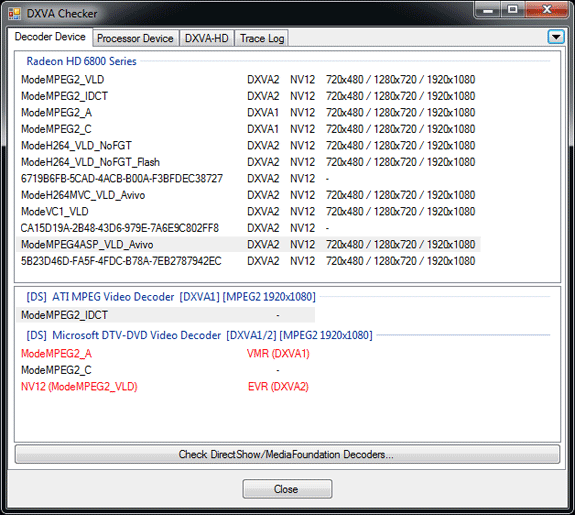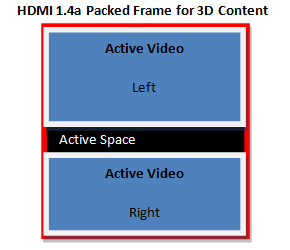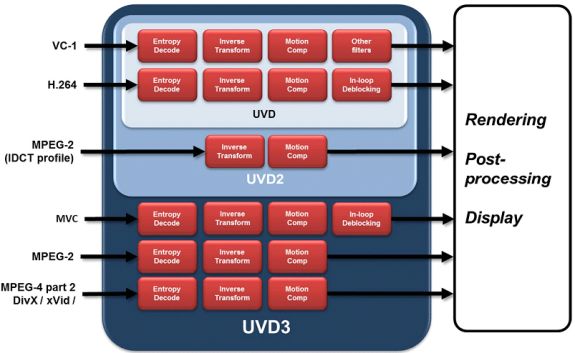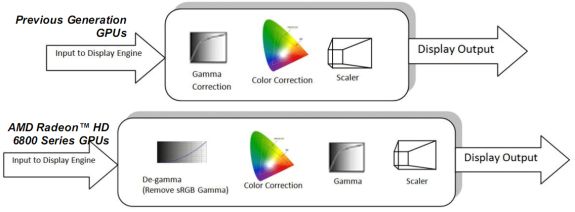AMD’s Radeon HD 6870 & 6850: Renewing Competition in the Mid-Range Market
by Ryan Smith on October 21, 2010 10:08 PM ESTSeeing the Present: HDMI 1.4a, UVD3, and Display Correction
DisplayPort wasn’t the only aspect of AMD’s display controller that got an overhaul however, AMD’s HDMI capabilities have also been brought up to modern standards. Coming from Cypress with support for HDMI 1.3, AMD now supports HDMI 1.4a on the Barts based 6800 series and presumably they will do so on the rest of the 6800 series too. With HDMI 1.4a support AMD can now support full resolution (1080p) 3D stereoscopy for movies, and 720p for games and other material that require 60Hz/eye, along with 4k x 2k resolution for monitors and TVs that have equivalent support. Unlike DP this has less to do with monitors and more to do with TVs, so the importance of this will be seen more on future AMD cards when AMD refreshes their lower-end parts that we normally use with HTPCs.
Launching alongside support for displaying full resolution 3D stereoscopic video is the hardware necessary to decode such video, in the form of the latest version of AMD’s Unified Video Decoder: UVD3. The last time UVD received a major update was with UVD2, which launched alongside the Radeon HD 4000 series and added partial MPEG-2 decoding support by moving IDCT and MoComp from shaders in to the UVD fixed function hardware.
With the Radeon 6800 series AMD is releasing UVD3, which like UVD2 before it builds on the existing UVD feature set. UVD3 is adding support for 3 more-or-less new codecs: MPEG-2, MVC, and MPEG-4 ASP (better known as DivX/XviD). Starting with MPEG-4 ASP, it’s the only new codec in supported by UVD3 that’s actually new, as previously all MPEG-4 ASP decoding was done in software when it came to AMD GPUs. With UVD3 AMD can now completely offload MPEG-4 ASP decoding to the GPU, bringing forth the usual advantages of greatly reducing the amount of work the CPU needs to do and ideally reducing power consumption in the process.
AMD adding MPEG-4 ASP support gives us an interesting chance to compare and contrast them to NVIDIA, who added similar support a year ago in the GT21x GPUs. AMD is a good bit behind NVIDIA here, but they’re making up for it by launching with much better software support for this feature than NVIDIA did; NVIDIA still does not expose their MPEG-4 ASP decoder in most situations, and overall did a poor job of advertising it. When we talked with DivX (who is AMD’s launch partner for this feature) they didn’t even know that NVIDIA had MPEG-4 ASP support. Meanwhile AMD is launching with DivX and had a beta version of the DivX codec with UVD3 support ready to test, and furthermore AMD is fully exposing their MPEG-4 ASP capabilities in their drivers as we see in this DXVA Checker screenshot.

The only downside at this time is that even with Microsoft’s greater focus on codecs for Windows 7, Windows 7 doesn’t know what to do with DXVA acceleration of MPEG-4 ASP. So while Win7 can play MPEG-4 ASP in software, you’re still going to need a 3rd party codec like the DivX codec to get hardware support for MPEG-4 ASP.
The other bit worth mentioning is that while AMD is launching support for MPEG-4 ASP decoding here on the 6800 series, much like HDMI 1.4a it’s not going to be a big deal for the 6800 series market. MPEG-4 ASP is a fairly lightweight codec, so support for it is going to be a bigger deal on low-end products, particularly AMD’s APUs if Llano and Bobcat end up using UVD3, as MPEG-4 ASP decoding in software requires a much greater share of resources on those products.
Up next is MPEG-2, which has been a codec stuck in limbo for quite some time over at AMD. MPEG-2 is even older and easier to decode than MPEG-4 ASP, and while GPUs have supported MPEG-2 decode acceleration as early as last decade, CPUs quickly became fast enough that when combined with low levels of hardware decode acceleration (inverse discrete cosine transform) was more than enough to play MPEG-2 content. Thus AMD hasn’t done much with MPEG-2 over the years other than moving IDCT/MoComp from the shaders to UVD for UVD2.
Because of the similarities between MPEG-4 ASP and MPEG-2, when AMD added support for full MPEG-4 ASP decode acceleration they were able to easily add support for full MPEG-2 decode acceleration, as they were able to reuse the MPEG-4 ASP entropy decode block for MPEG-2. As a result of including full MPEG-4 ASP decode acceleration, AMD now supports full MPEG-2 decode acceleration. Even more so than MPEG-4 ASP however, the benefits for this are going to lie with AMD’s low-end products where getting MPEG-2 off of the CPU should be a boon for battery life.

The final addition to UVD3 is support for Multiview Video Coding, which isn’t a new codec per se, but rather is an extension to H.264 for 3D stereoscopy. H.264 needed to be amended to support the packed frame formats used to store and transmit 3D stereoscopic videos, so with UVD3 AMD is adding support for MVC so that UVD can handle Blu-Ray 3D.
Finally, coupled with support for new codecs and new display outputs in AMD’s display controller is a refinement of AMD’s existing color correction capabilities in their display controller. Cypress and the rest of the 5000 series could do color correction directly on their display controllers, but they could only do so after gamma correction was applied, meaning they had to work in the non-linear gamma color space. Technically speaking this worked, but color accuracy suffered as a result. With the 6800 series’ new display controller, AMD can now perform color calibration in linear space by converting the image from gamma to linear color space for the color correction, before converting it back to gamma color space for display purposes.
As color correction is being used to correct for wide-gamut monitors the importance of this change won’t be seen right away for most users, but as wide-gamut monitors become more widespread color correction becomes increasingly important since wide-gamut monitors will misinterpret the normal sRGB colorspace that most rendering is done in.












197 Comments
View All Comments
GeorgeH - Friday, October 22, 2010 - link
WRT comments complaining about the OC 460 -It's been clear from the 460 launch that a fully enabled and/or higher clocked 460 would compete very well with a 470. It would have been stupid for NVIDIA to release such a card, though - it would have made the already expensive GF100 even more so by eliminating a way to get rid of their supply of slightly defective GF100 chips (as with the 465) and there was no competitive reason to release a 460+.
Now that there is a competitive reason to release one, do you really think Nvidia is going to sit still and take losses (or damn close to it) on the 470 when it has the capability of launching a 460+? Do you really think that Nvidia still can't make fully functional GF104 chips? Including the OC 460 is almost certainly Ryan's way of hinting without hinting (NDAs being what they are) what Nvdia is prepping for release.
(And if you really think AT is anyone's shill, you're obviously very new to AT.)
AnandThenMan - Friday, October 22, 2010 - link
"And if you really think AT is anyone's shill, you're obviously very new to AT."Going directly against admitted editorial policy doesn't exactly bolster your argument now does it. As for your comment about a 460+ or whatever you were trying to say, who cares? Reviews are supposed to be about hardware that is available to everyone now, not some theoretical card in the future.
MGSsancho - Friday, October 22, 2010 - link
A vendor could just as likely sell an overclocked 470 card as well as a 480. But I think you made the right assumption that team green might be releasing overclocked cards that all have a minimum of 1gb of ram to make it look like their cards are faster than team red's. maybe it will be for near equal price points, the green cards will all be 20~30% overclocked to make it look like they are 10% faster than the red offerings at similar prices. Red cards could just be sold over clocked as well (we have to wait a bit more to see how well they overclock). All of this does not really matter. In the end of the day, buyers will look at whats the fastest product they can purchase at their price point. Maybe secondly they will notice that hey this thing gets hot and is very loud and just blindly blaming the green/red suits and thirdly they will look at features. Who really knows.Personally I purchase the slightly slower products then over clock them myself if i find a game that needs it. I would rather have the headroom vs buying a card that is always going to be hot enough to rival volcanoes even if it is factory warrantied.
Golgatha - Friday, October 22, 2010 - link
The nVidia volcanoes comment is really, really overstated. I have a mid-tower case with a 120mm exhaust and 2x92mm intakes (Antec Solo for reference), and a GTX 480. None of these case fans are high performance fans. Under very stressful gaming conditions, I hit in the 80-85°C range, and Folding@Home's GPU3 client will get it up to 91°C under 100% torturous load.Although I don't like the power consumption of the GTX 480 for environmental reasons, it is rock solid stable, has none of the drawbacks of multi-GPU setups (I actually downgraded from a Crossfire 5850 setup due to game crashing and rendering issues), and it seems to be top dog in a lot of cases when it comes to minimum FPS (even when compared to multi-GPU setups).
Parhel - Friday, October 22, 2010 - link
"And if you really think AT is anyone's shill, you're obviously very new to AT"I think you're referring to me, since I'm the one who used the word "shill." Let me tell you, I've been reading AT since before Tom's Hardware sucked, and that's a loooong time.
If I were going to buy a card today, I'd buy the $180 GTX 460 1GB, no question. I'm not an AMD fan, nor am I an NVidia fan. I am, however, an Anandtech fan. And their decision to include the FTW edition card in this review means I can no longer come here and assume I'm reading something something unbiased and objective.
GeorgeH - Friday, October 22, 2010 - link
It was actually more of a shotgun blast aimed at the several silly posts implying AT was paid off by EVGA or Nvidia.If you've been reading AT for ~10 years, why would you assume that Ryan (or any other longtime contributor) suddenly decided to start bowing to outside pressure? If you stop lighting the torches and sharpening the pitchforks for half a second, you might realize that Ryan probably has a very good reason for including the OC card.
Even if I'm smoking crack WRT a GTX460+, what's the point of a review? It's not to give AMD and Nvidia a "fair" fight, it's to give us an idea of the best card to spend our money on - and if AMD or Nvidia get screwed in the process, I'm not going to be losing any sleep.
Typically, OC cards with a significant clock bump are fairly rare "Golden samples" and/or only provide marginal performance benefits without significantly increasing heat, noise, and power consumption. With the 460, Nvidia all but admitted they could've bumped the stock clocks quite significantly, but didn't want to threaten their other cards (*cough* 470 *cough*) if they didn't have to. This is reflected in what you can actually buy at Newegg - of the ~30 1GB 460's, only ~5 are running stock. 850MHz is still high, but is also right in line with the average of what you can expect any 460 to get to, so I don't think it's too far out of place.
Repeating what I said above, including the OC card was unfair to AMD, but is highly relevant to me and my wallet. I couldn't care less if AMD (or Nvidia) get screwed by an AT review - I just want to know what's best for me, and this article delivers. If the tables were turned, I'm sure that Ryan would have no problem including an OC AMD card in a Nvidia review - because it isn't about being a shill, it's about informing me, the consumer.
SandmanWN - Friday, October 22, 2010 - link
What? Put the crack down... Really, if you are short on time to review a product and you steal time away from that objective just to review a specially delivered hand selected opponents card instead of completing your assignment then you've not exactly been genuine to your readers or in this case to AMD.If you have time to add in an overclocked card then you need to do the same with the review card, otherwise the OC'd cards need to wait another day.
I have no idea how you can claim some great influence on your wallet when you have no idea of the OC capabilities of the 6000 series. If you actually bought the 460 off this review then you are banking that the overclock will hold up against a unknown variable. That's not exactly relevant to anyone's wallet.
GeorgeH - Friday, October 22, 2010 - link
An OC'd 460 competes with the 6870, and the 6870 doesn't really overclock at all.Even overclocked, a 6850 isn't going to touch a 6870, unless you're going to well over 1GHz (which short of a miracle isn't going to happen.)
It was disappointing that the review wasn't fleshed out more, but I'd say what's missing isn't as relevant to my buying decisions as how well the plethora of OC'd 460s compare to the 6870.
Parhel - Saturday, October 23, 2010 - link
"the 6870 doesn't really overclock at all"What? You're talking out of your ass No review site has even attempted a serious overclock yet. It's not even possible, as far as I know, to modify the voltage yet! We have no way to gauge how these cards overclock, and won't for several weeks.
"850MHz is still high, but is also right in line with the average of what you can expect any 460 to get to"
Now you're sounding like the shill. 850Mhz is not a realistic number if we're talking about 24/7 stability with stock cooling. No way.
GeorgeH - Saturday, October 23, 2010 - link
850MHz unrealistic? Nvidia flat out admitted that most cards are capable of at least ~800MHz (no volt mods, no nothing) and reviews around the web have backed this up, showing low to mid 800's on most stock cards, at stock voltages, running stock cooling. If you're worried about reliability, grab one of the many cards that come factory OC'd with a warranty.The 6870 doesn't now and never will overclock much at all, at least not in the way the 460 does. As with any chip, there will be golden sample cards that will go higher with voltage tweaks and extra cooling, but AMD absolutely did not leave ~20-25% of the 6870's average clockspeed potential on the table. The early OC reviews back this up as well, showing the 6870 as having minimal OC'ing headroom at stock voltages.
If you're waiting to compare the maximum performance that you can stretch out of a cherry-picked 6870 with careful volt mods and aftermarket cooling, you're going to be comparing it with a 460 @ ~950MHz, not ~850MHz.
As a guess, I'd say that your ignorance of these items is what led you to be so outraged at the inclusion of the OC 460 in the review. The magnitude of the OC potential of the 460 is highly atypical (at least in mid-range to high end cards), which is why I and many other posters have no issue with its similarly atypical inclusion in the review.